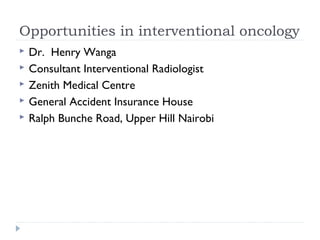
Opportunities in interventional oncology by henry wanga
- 1. Opportunities in interventional oncology Dr. Henry Wanga Consultant Interventional Radiologist Zenith Medical Centre General Accident Insurance House Ralph Bunche Road, Upper Hill Nairobi
- 2. KESHO Kenya Society of Hematology and Oncology Third Annual Scientific Conference Panafric Hotel, Nairobi Kenya 28th November 2014
- 3. Angiography, Biopsy and Drainage Interventional Radiology(IR) is a clinical subspecialty with a rich history of innovations We approach our work through clinical problem solving with our referring specialists Many IR practices have shifted from peripheral vascular interventions to interventional oncology Multimodal imaging methods have superseded the traditional arteriography Embolic agents can be permanent, temporary, or combined with an agent such as chemotherapy Pelvic malignancies may cause lower extremity deep vein thrombosis. Treatment is by placing permanent or temporary inferior vena cava filters Complications in IR practice are uncommon
- 4. Oncologic applications VASULAR A. diagnostic information(e.g. vascular invasion, biopsy) Diagnosis and treatment of associated conditions,(DVT, central venous access, hemorrhage) Local delivery of chemotherapy Embolotherapy Brachytherapy delivery 2. NON-VASCULAR Diagnostic information(PTHC, biopsy) Treatment of associated conditions (e.g. GI/GU/ biliary obstruction) Local tumor ablation(RF/ thermal, ethanol,acetic acid,cisplatin -epigel)
- 5. Continued Oncologic applications Brachytherapy delivery 3. Disease control vs. palliation 4. Connections with Basic Science(small animal, cellular culture, etc) and Clinical Research(clinical trials)
- 6. Interventional Radiology locally practices Image guided tumor ablation with ethanol Transcatheter arterial embolization(TAE) Transcatheter arterial chemoembolization(TACE) Combined TAE and TACE
- 7. Agents used in embolization treatment of malignancies Gelfoam sponge temporary –haemostasis Poly vinyl alcohol particles (PVA) - permanent occlusion. Comes in sizes 100, 200, 300, 500,700,or 1000 microns Drug eluting beads (DEB) Coils
- 8. Chemo infusion Agents Cisplatin Doxorubicin Mitomycin c Paclitaxel And many others
- 9. Hepatocellular carcinoma: Solitary tumor <3 cm Treatment/Procedure Rating Comments Systemic chemotherapy 3 Resection 8 Transplantation 9 Chemical ablation 6 Thermal ablation 8 Tran arterial embolization (TAE) 5 Tran arterial chemoembolization (TACE) 5 Selective internal radiation therapy (SIRT) 5 Rating Scale: 1,2,3 Usually not appropriate; 4,5,6 May be appropriate; 7,8,9 Usually appropriate
- 10. Hepatocellular carcinoma: Solitary tumor 5 cm Treatment/Procedure Rating Comments Systemic chemotherapy 3 Resection 8 Transplantation 9 The tumor is too large for chemical ablation. May Chemical ablation 3 use it instead of or in addition to thermal ablation depending on tumor location. Thermal ablation 5 Tran arterial embolization (TAE) 6 Tran arterial chemoembolization (TACE) 7 Selective internal radiation therapy (SIRT) 7 Especially applicable in portal vein thrombosis or extensive bilobar disease. Transarterial chemoembolization (TACE) 7 combined with thermal ablation Rating Scale: 1,2,3 Usually not appropriate; 4,5,6 May be appropriate; 7,8,9 Usually appropriate
- 11. Metastatic liver disease: Multifocal colorectal carcinoma (liver dominant or isolated), 5 cm tumors. Treatment/Procedure Rating Comments Systemic chemotherapy 9 Resection 7 Transplantation 1 Chemical ablation 1 Thermal ablation 2 Hepatic arterial chemotherapy infusion 5 Transarterial embolization (TAE) 5 Transarterial chemoembolization (TACE) 5 Selective internal radiation therapy (SIRT) 5 Transarterial chemoembolization (TACE) 5 Depends on tumor burden. combined with thermal ablation Rating Scale: 1,2,3 Usually not appropriate; 4,5,6 May be appropriate; 7,8,9 Usually appropriate
- 13. Radionuclide Bone Scan Normal bone scan
- 14. Metastatic breast cancer Radionuclide 99Tc studies
- 15. IGS for Interventional Oncology Innova* Image Guided Systems (IGS) for Interventional Oncology provide excellent image quality with exceptional dose efficiency. Get excellent organ coverage for tumor embolization, ablation techniques, and 3D guidance. Our flagship Innova IGS 540 with the Innova CT option enhances soft tissue visualization for imaging of high- and low-density tissues.
- 16. IGS for Interventional Oncology
- 17. Liver surgical anatomy Anterior surface showing eight divisions
- 18. Hepatic veins and portal veins Segmental Porto-venous circulation
- 19. The Mater hospital Cat lab Ceiling suspended C-ARM Angiography unit
- 20. Left hepatic lobe hemangioma Achieved complete hemangioma embolisation end point
- 21. Hepatic hemangioma Symptoms: nausea, right hypochondriac pains and anorexia. All disappeared after treatment with poly vinyl alcohol particles
- 22. TACE and Chemoembolization After a second course
- 23. HEPATOMA
- 24. Embolisation with coils, following polyvinyl alcohol particles
- 25. Discussion Hepatocellulacr carcinoma is the most common primary malignancy of the liver Predisposed in patients with chronic liver diseases such as cirrhosis, hemochromatosis, alcoholism and glycogen storage disease Hepatitis Chas been attributed to lead to increase HCC in the United States. Age at presentation is in the sixth and seventh decades In Kenya the incidence is in the fourth and fifth decades
- 26. Major patterns of growth of HCC Solitary mass Multifocal masses Diffusely infiltrating mass
- 27. Hepatic metastasis This is the most common malignancy of the liver arising from the colon, stomach, pancreas, breast, and lung neoplasm In children, metastases are commonly from neuroblastoma and Wilm’s tumor Prognosis depends on the primary tumor site.
- 28. Metastatic cholangiocarcinoma Axial CT scan slice
- 29. Biliary drainage Ward nurses PAA
- 30. Let us go on a hunting mission Masai Mara
- 31. Acknowledgements Aga Khan University hospital, Karachi, Pakistan Lifestyle, hospital, Pretoria The Nairobi Hospital Many colleagues; Dr. Abwao, Dr. Njuguna, Dr. Ndagwatha, Dr. Githaiga, Dr. Otele, Dr. Nyongesa, Dr. Ochieng( now studying in South Africa) Radiology colleagues especially the late Dr. Sara Goretti Tata Colleagues at Mulago Hospital, Makerere University, Kampala Uganda Indeed all of YOU